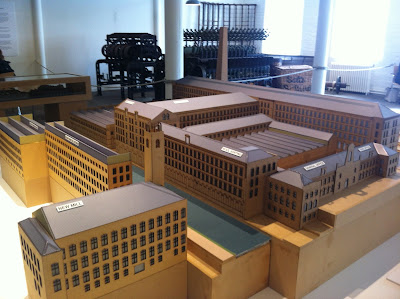 |
| | Salt Mill in Yorkshire – the inspiration for Malbrough Mills, perhaps? | |
England Trip 2015 Travel Journal
Sunday, March 29 – Part One
What a country! Today was quite a literary and historic adventure. We visited the Brontë Parsonage and an old woolen mill in a countryside dotted all over with mills – some abandoned, some repurposed – on wild, windy hills. I felt like I'd been dropped into North & South, Wuthering Heights and Jane Eyre! Truly.
 |
| There is nothing like Yorkshire scenery! |
These surroundings obviously contributed so much to the stories and literary styles of Mrs. Gaskell and the Brontë sisters. The wild and rugged scenery, with heaps of clouds swirling furiously across the grey sky and the constant wind seem to have bred the independent spirit of their fierce characters, and woven itself into the stories themselves. It begins to weave itself into you if you stand out in it long enough!
We were on our way to Keighly (pronounced "keeth-lee") where some 'North & South' scenes were filmed, when we saw a sign for Salt Mill, a preserved historical site (indicated by the sign's brown color). So I made the decision to take a quick detour to explore it and to see the inside of a textile mill. It was basically on our way, after all, and it turned out to be an exciting, memorable experience!
 |
| Salt Mill with its smokestack. |
On the third floor is an exhibit on the history of the mill, opened in 1853 by Titus Salt, and it was considered to be a model mill in its time, innovative with its technology and clean working conditions. (He sounds a bit like Mr. Thornton to me.) There were two original machines on display, and imagining one of these enormous rooms packed with rows and rows of them helped me to understand better than I ever had before Margaret Hale's initial repugnance at the idea of a mill, and especially of mill owners, as well as her pity of the working people. My understanding was quite vivid, in fact. The monotony of the nose and confinement oppressed my very imagination. And that was looking at an exceptionally comfortable mill!
 |
| Original machines from Salt Mill, used in making wool cloth. |
 |
| One of the upper floors of the mill, now a little museum. |
 |
| The back of Salt Mill |
 |
| The ground floor of the mill. It's rather beautiful now, making it a bit hard to imagine it filled with the whir of machines. |
 |
| A model of Salt Mill – it's like a small city! |
The third floor had an impressive view of the town outside – a town that looks exactly like I imagine Milton would look, with its grey stone and the spires of other mills dotting the skyline.
 |
| The town of Shipley, looking out from Salt Mill. Doesn't it look like Milton?? |
North & South was set in a real time and based on real places and people so seeing these real cities and mills brought that history so much closer. It almost felt real enough to touch. This is why I love to travel! Well, one big reason.
 |
| A project to remember the people who worked in Salt Mill. Here is Sarah Ann Morton – who knows, maybe we're related! That made history seem really close... |
© 2016 Anna Morton

No comments:
Post a Comment